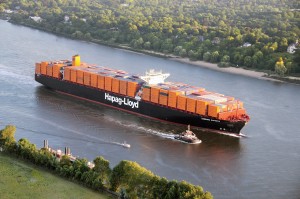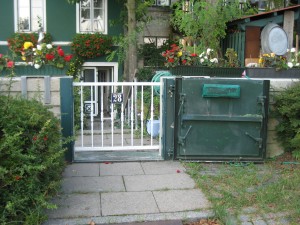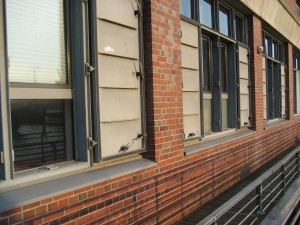HAMBURG is a special city. Having recovered from a real pounding during WWII, it’s become the 2nd largest port in Europe. The prosperity coming with that is everywhere evident, not least along the waterways: the many canals, and the large Elbe River, itself, with its energetic commerce. Many of the canals are lined with beautiful homes and trendy old brick warehouse conversions.
The Elbe is its own trip. On the West bank resides the container ship port with all the ship traffic, giant cranes simultaneously unloading and reloading ships, and robotic vehicles transporting the containers to and from awaiting trains and trucks.
The East bank is a peaceful old district of homes, offices and beaches from which people enjoy watching the action going on in the port across the river.
On a walk along the East bank, I noticed some odd-looking walls and asked our Hamburg friends Gunther and Barbara about them. They told me a fascinating story.
The East bank may be peaceful most of the time, but not always. Roughly once a year, things get very wet. During the spring freshet, the rains swell the river, moving downstream to the Northwest. Meanwhile, North Sea tides and winds move water upstream toward the Southeast. The slow, wet collision of these forces materializes around Hamburg and, among other flooding, inundates the East bank.
Why not build a big dam or other major barrier to prevent the flooding? Because this would cut off shipping – the city’s life-blood. Then why not build high levees along the East bank to protect all the buildings there? Because it would eliminate the view of the river and other bank – the reason the buildings of this high-rent district are there in the first place.
What to do? The people of Hamburg have lived with this problem of flooding for centuries, and know when the floods come and how high they get (usually). They figured out how to deal with it long ago.
Forget great engineering feats; big monolithic strategies with their enormous cost, potential single points of failure and disruption. To protect East bank properties, use instead a distributed strategy of small, localized, largely private solutions to the problem.
For the homes, put low berms in front of the up-sloping properties on the bank. On top of the berms, and as far up the slope as necessary, the property owners put their own personal dikes: low water-proof walls with water-tight gates. Let the flood come; just close the gate and clamp it tight.
Meanwhile, the upper stories of the homes always have their views and the properties stay dry year round.
Similarly for commercial buildings, a distributed strategy consisting of a variety of customized solutions is used. Some simply close water-tight shutters and doors on lower stories when the flood-as-usual comes. Others elevate buildings on stilts. Some use a combination. Flood damage be gone.
A distributed flood-proofing strategy works well along Hamburg’s East bank.
Distributed vs. Centralized Strategies
In previoius posts, we’ve talked about certain types of strategy, such as Cooperative & Adversarial, Defensive & Offensive, Control strategy, etc. Distributed and Centralized strategies are additional types, with their own characteristics. So what do I mean by a “distributed strategy”? One in which an overall objective is met by using many substrategies, each with an objective contributing to the overall one.
Like protecting a neighborhood from flooding by protecting the individual properties from flooding (perhaps each in its own way) – vs. a common levee, say.
I’m not disparaging centralized strategies. Sometimes they’re the best solution – and even the only possible solution. But sometimes not. Let’s look at some examples.
Trees – Autumn in the Rockies is really gorgeous in the alpine zone with the large stands of brightly colored aspen contrasting with their dark green ponderosa and various other pine neighbors. Individual pines are “normal” trees, distributed across the landscape as groups of standalone trees: each with one base, one superstructure, and one root system.
But the aspen species has followed a more centralized strategy. Groves of aspen share a common root structure, with the individual trunks being genetically identical. This is to say that the grove is the individual of the species, not the things sticking up that we call “trees”.
[Momentary diversion: as a consequence of a centralized root system, the largest individual organism in the world (by area) is an aspen grove in Utah that covers 106 acres (and weighs-in somewhere around 6 million kilograms). OK, back to the topic …]
For aspen, a large, shallow, interconnected root system provides an advantage for surviving in the alpine zone. This kind of structure forms a huge base that handles high winds, steep slopes and rock slides very nicely. And parts of the grove that aren’t over good water or nutrient sources can be fed by those parts that are. In the photo, you can make out different neighboring aspen groves at different stages of the Fall color change: light green, yellow and gold.
The rugged pines (dark green in the picture), with their individual root systems, survive nicely, too. Their roots penetrate the rocky soil very well to find the water and nutrients they need, and wrap around large rocks to provide stability on steep slopes and in high winds.
In this case, both types of strategy work just fine in response to the same alpine survival barriers.
Electric Motors – Consider strategies for delivering power to tools. By the mid-1800’s, electric motors were becoming just practical enough to begin replacing steam engines in factories and large shops. Like the steam engines they were replacing, electric motors were very large and heavy, and were suitable only for large operations.
A typical motor was so big that it had to be centralized and connected to the various tools and machines on the factory floor by a contraption of overhead leather belts, driving wheels and pulleys.
Over time, with Tesla’s invention of the alternating current motor, a useful power grid and other technology improvements, the motors became smaller and able to deliver much more power for their size.
This enabled a flexible distributed strategy in which tools could each have their own motors, rather than being dependent on a single central motor and contraption.
Subsequently, improved battery technology allowed for powerful lightweight tools that are truly mobile. This enabled the flexibility of being able to bring the tool to the work, rather than having to bring the work to the tool – with a massive impact on how things are manufactured and repaired.
Meanwhile, practical electric motors were getting small and commoditized enough to power all sorts of consumer items, including wristwatches. Halfway through a nice bottle of Malbec, my Brother-in-law David and I decided it would be a good idea to count all the electric motors in my household. We found 107 before going back to the wine. Try it: room by room, car by car. You might be surprised. And don’t forget the fans in your computers.
Computers – Speaking of which, computers have gone through the same pattern of strategy evolution, from centralized to distributed, as electric motors. An early computer would fill a large room. To use it, you had to go to it with a box of punch cards in hand, wait for your job to be executed, and then eventually receive a printout of results and your box of cards – maybe a day later. A company’s or institution’s computing power was usually centralized in one really big computer.
 As hardware and software technology improved, midi-computers emerged, then minis, then micros, enabling much greater affordability and subsequent proliferation. Once personal computers became available, localization, mobility, autonomy and productivity increased greatly, radically changing work patterns.
As hardware and software technology improved, midi-computers emerged, then minis, then micros, enabling much greater affordability and subsequent proliferation. Once personal computers became available, localization, mobility, autonomy and productivity increased greatly, radically changing work patterns.
In cases in which technology can be packaged for consumers (the really big market), strategy tends to shift from centralized to distributed forms.
Big Science – But there are many cases in which a distributed strategy isn’t up to the task. If you need to look into really deep space, it doesn’t help to have a thousand astronomers looking through their own little personal backyard telescopes. A really big one with sufficient magnification and field of view is what’s needed, right?
And the recent highly publicized Higgs Boson verification couldn’t have been made with backyard particle accelerators, either. It took the caliber of the giant CERN accelerator to do the job.
Putting them together – When we take a broad look we find that many strategies combine the two types. Companies often have a high level business strategy comprised of lower level strategies with their own objectives contributing to the overall company objective (embodied in lower level independent business units – think General Electric or Hewlett Packard). The military and other large organizations tend to structure themselves this way, too.
All of this goes to say that when setting out to devise a strategy, it’s a good idea to think through which type of strategy is the most appropriate – distributed, centralized, or a combination – before taking the design too far.
______________________________________________
Readers are encouraged to add comments to this post.
And if you’d like to share or recommend the post, click on your preferred way in the left margin sidebar.
Be sure to watch for the next post.
If you’re not currently being automatically notified when new posts are published, then please Follow Real Strategy (top of right hand column on this page), and indicate how you’d prefer to be notified.
For other posts of interest, look in the Smart Menu.
Photo credit: Approaching Hamburg on the Elbe River, Hapag-Lloyd
Photo credit: Aspen Groves, Maroon Bells/Snowmass Wilderness, Skyhaven’s Cool Thing of the Day
Photo credit: Power Distribution Contraption, by John Harvey, Pencil Sketches at the Old Schwamb Mill
Photo credit: Early Centralized Computing Power, Roger Mills
Photo credit: Distributed Computing Power, Times of News












I really enjoyed this post. I wonder if the different color tints among the aspens represent different organisms. Also, the cluster of aspens in my back yard is in serious decline, in fact almost dead now, but the new “volunteers” they have sent out into my lawn are thriving. Seems like a great way to keep the genotype in the game, even though the large stems are about to expire.
[Translate]
Thanks. Yes, it finally occurred to me that the different tints reflected different individual organisms when I saw completely distinct, clearly different colors, in adjacent groves on the slopes of Grand Mesa. I’ve subsequently read that that’s the case. I’m sure you’re right about keeping the genotype in the game. The aggression of the aspen volunteers is really impressive. The aspens in our yard have sent them from one side of our house, clear under the house, to the other side.
[Translate]
I believe your example is less about “strategy” per se, and much more about the emergence of spontaneous order from complex individual actions. Perhaps it is a matter of semantics, but I think not.
[Translate]
Thanks for commenting, Romey. Would I be right that the example yoiu refer to is “Trees”?
[Translate]
It was a good description how the Hamburg people deal with the Hochwasser. At the moment we have the probleme that there is not enough water in the Elbe because the biggest container ships from China can`t get into Hamburg harbour.( From the north sea, that is a distance of 150 km.)
[Translate]
Thanks. The Chinese ship captains will just have to circle out there in the North Sea, playing cards, and praying for the Hochwasser to return. Is the problem that the water is unusually low at this time, or that the ships are becoming bigger? Or both?
[Translate]